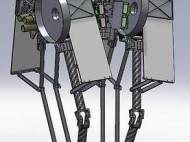OSU researchers advance robot walking and running abilities
 Researchers at Oregon State University have made an advance in robotics by improving the robots movement. The robots can walk and run effectively, while they use little energy in the process as well. By achieving an optimal approach with robotic mechanisms, studies are moving closer to creating better robots and prosthetic limbs for humans that work much better.
Researchers at Oregon State University have made an advance in robotics by improving the robots movement. The robots can walk and run effectively, while they use little energy in the process as well. By achieving an optimal approach with robotic mechanisms, studies are moving closer to creating better robots and prosthetic limbs for humans that work much better.
“Researchers have been working toward robot locomotion for a long time based mostly on experience and intuition,” said Jonathan Hurst, an assistant professor of robotics and mechanical design at OSU. “What we’ve done is taken a step back to analyze the fundamental dynamics of the mechanical system, what behavior is really possible for a given robotic system. A rock can’t fly, no matter what software you write for it. This is an important advance and gives us a new foundation to tell what actually will and won’t work before we even try to build it.”
In terms of locomotion, robots are currently lagging behind humans and other animals. While using limited energy, we can move easily over uneven terrain, and respond with a fascinating balance of muscles and tendons. We’re also able to respond to outside influences, such as delicate act of holding a cup of coffee level during a bumpy car ride.
In their recent studies (PDF), the OSU researchers essentially proved that these two abilities are mutually exclusive. Humans deal with this problem by flexing opposing pairs of muscles, to change the dynamic properties of their arm. For a robot, the more it is able to do one of these tasks, the less able it is to do the other.
“If robotic locomotion is ever to achieve some of what we want, it will have to use less energy,” Hurst said. “There are machines that can walk with no active controls at all, using barely any energy, but they fall if they run into the smallest bump. We need to use as much of that passive ability as possible and only use motors or active controls if it’s really necessary, so we can save energy in the process.”
In part because it’s consistent with these goals, the OSU researchers also hope to win what’s called the “W” Prize, a $200,000 award that’s been promised for the first robot that can move 10 kilometers within 10,000 seconds, through and over obstacles, using less energy than it would take a human to do the same task.
Part of the OSU research are studies under way with colleagues in England to examine ostriches, and make direct comparisons to the robot behavior. Animals, including ostriches, have a great ability to respond to unexpected disturbances while running, and can provide insights into the needed robotic equivalent – combining spring-mass models with “force control actuators.”
“Long term, there’s no reason we shouldn’t be able to build robots or robotic devices with excellent locomotion ability,” Hurst said. “Clearly this might be useful for some military or police applications in highly dangerous situations. But I could also see great improvements possible with prosthetic limbs that work much better than existing technology, or even the creation of exoskeletons that might allow someone with limited motor ability to walk effectively.”









Leave your response!